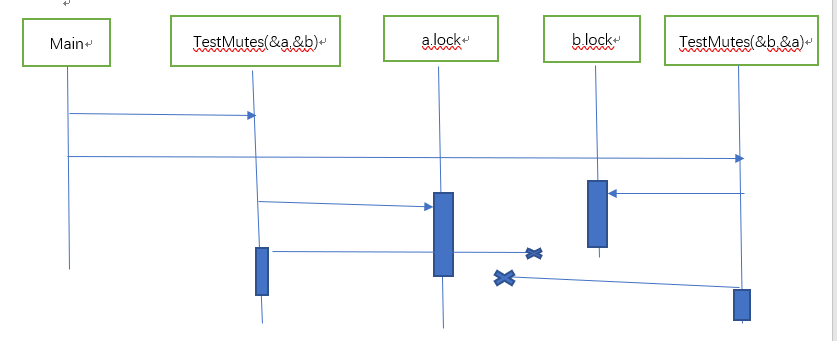Deadlocks and live locks
Deadlock: it will make all concurrent programs waiting. If there is no external intervention, the program cannot be recovered
type values struct{
mu sync.Mutex
value int
}
func TestMutes(v1, v2 *values){
defer wg.Done()
v1.mu.Lock()
defer v1.mu.Unlock()
time.Sleep(2*time.Second)
v2.mu.Lock()
defer v2.mu.Unlock()
fmt.Println("v1+v2=:",v1.value+v2.value)
}
var wg sync.WaitGroup
func main(){
var a = values{
value:1,
mu:sync.Mutex{},
}
var b = values{
value: 2,
mu:sync.Mutex{},
}
wg.Add(2)
go TestMutes(&a,&b)
go TestMutes(&b,&a)
wg.Wait()
}
fatal error: all goroutines are asleep - deadlock!
Deadlock occurs due to time problem. Code running time:
There are four ways to detect, prevent and correct deadlocks:
- Mutual exclusion: concurrent processes have exclusive rights to resources at the same time
- Wait condition: concurrent processes must have one resource at the same time and wait for additional resources
- No preemption: resources owned by a concurrent process can only be released by the process
- Cyclic waiting: a concurrent process p1 must wait for a series of other concurrent processes p2, p2 is also waiting for p1
The resources of goroutine in the above code cannot be achieved (no preemption)
Livelock: a program that is actively executing concurrent operations, but these operations cannot advance the state of the program
//Simulation of people passing through the corridor
func main(){
cadence := sync.NewCond(&sync.Mutex{})
go func(){
for range time.Tick(1 *time.Millisecond){
cadence.Broadcast()
}
}()
takeStep := func(){
cadence.L.Lock()
cadence.Wait()
cadence.L.Unlock()
}
//tryDir allows a person to try to move in one direction
tryDir := func(dirName string, dir *int32, out *bytes.Buffer)bool{
fmt.Fprintf(out,"%v",dirName)
atomic.AddInt32(dir,1)//Move in one direction
takeStep() //Everyone moves at the same pace
if atomic.LoadInt32(dir)==1{
fmt.Fprintf(out,".Success!")
return true
}
takeStep()
atomic.AddInt32(dir,-1)//It means you can't leave
return false
}
var left, right int32
tryLeft := func(out *bytes.Buffer)bool{return tryDir(" left ",&left,out)}
tryRight := func(out *bytes.Buffer) bool{return tryDir(" right ",&right,out)}
walk := func(walking *sync.WaitGroup, name string){
var out bytes.Buffer
defer func() {fmt.Println(out.String())}()
defer walking.Done()
fmt.Fprintf(&out, "%v is trying to scoot:",name)
for i := 0; i < 5; i++{//Limit the number of attempts
if tryLeft(&out) || tryRight(&out){//First try to the left
return
}
}
fmt.Fprintf(&out,"\n%v hello!",name)
}
var peopleIn sync.WaitGroup//Simulate two people
peopleIn.Add(2)
go walk(&peopleIn,"tom")
go walk(&peopleIn,"alice")
peopleIn.Wait()
}
//Result:
//alice is trying to scoot: left right left right left right left right left right
alice hello!
tom is trying to scoot: left right left right left right left right left right
tom hello!
tom and alice Will continue to compete before exiting